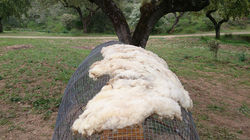
Bob Budd (UK)
Untitled
I believe my art gains through a dialogue with social space and therefore I have chosen to work primarily in the area of site specific or public art.
On one level, art can simply open up the area of creativity in our common spaces, but it can also reveal the spirit in our everyday lives and provide signposts that direct our thoughts and mirror the concerns we may have for the environment and for our culture.
In the dialogue with social space I attempt to give form to the complexities and concerns of contemporary life. This world of questions is mirrored by my visual language which is in itself often questioning, at times ironic, humorous or surreal, but also, I hope, to the point.
 |  |
|---|---|
 |  |
 |  |
Carlos de Gredos (Spain)
Untitled
In a house what is most important, the facade or the inside? In the case of the artist one we believe it is the interior, what is not always visible, even if his artwork is the faithful reflection of his spirit. For this house, the interior is made up of thousands of tiny cocoons, as if they were the size of the silkworm, but what you see from the outside is only one. The wool material is important for being protective and natural. It is no accident that it is raised without contact from the ground and resting in the branches of a holm oak. The place of dreams start out form the land to raise, as this house where we do not know its entrance
Iron mesh structure and wool freshly sheared / holm oak. 82 x 312 x 63 cm
 |  |
|---|---|
 |  |
 |  |
 |  |
 |
Raquel de Prada (Spain)
Untitled
My project, as my dream, is to follow the process of wool, (which I saw as a child and whose testimonies I have been able to recover in rural areas). Perhaps finishing a soft sculpture, installation or whatever comes out.
Shear, wash, rip, spin, twist, group in skeins, wind, weave, make shapes, wrap, weave on a loom, felt etc. I imagine that you could also become the she eps’ friend, right?
I have been collecting some tools on my trips to work with the wool and I would also love to take them and make an artist's book, I do not know how big. The work will gradually evolve .....
 |  |
|---|---|
 |  |
 |
Graham Keddie (Spain)
Untitled
... Much of my work is part of an incubation of complex thoughts and questions. Nothing is finished, all works are rather like annotations, estimations, equations that get as far as they can and generally fail in a cycle of paradox.
The creative research or journey is possibly the most important element to me in my work. Therefore, the materialisation of any work and the aesthetic involved is a result of this. Currently I; make objects, film, text, installation, photography, use of print, graphics and book formats.
 |  |
|---|---|
 |  |
 |
Carmen Madreña-Roja (Spain)
Untitled
Desde hace años desarrollamos un proyecto consistente en la instalación de huellas con formas y tamaños variables, de lana de oveja, en lugares donde anduvieron rebaños, sobre todo los de nuestras montañas. Nuestras intervenciones con lana hasta el momento se han realizado generalmente al aire libre, sobre soportes variables (hierba, canchal de piedra, roca, escombro…) Podríamos adaptarnos al soporte y elegir in situ la forma de la huella a realizar. El reto mayor nos lo plantea trabajar con lana recién esquilada. Nuestro trabajo con la lana siempre ha empezado yendo a lavarla al río. Aquí, al tratarse de lana no lavada habrá que ver cómo se comporta y qué efecto de color tiene. Pero, pensando en la lana en esa fase, la idea sería quizá envolver algo grande con ella, afieltrándola como un gran envoltorio… Pero esta no es más que una idea de partida...
 |  |
|---|---|
 |  |
 |  |
Che Marchesi (Spain)
Transracialismo en el que la esencia del mismo es la revisión del concepto de raza y de los aspectos exteriores de la piel. Me ha resultado curiosa encontrar en vuestra convocatoria la apreciación del hecho de tener una oveja negra incluida. Quisiera proponeros en mi participación trabajar con este concepto aprovechando la lana de esta oveja para disfrazar a otras y a esta misma disfrazarla de blanca buscando generar dudas y situaciones poéticas ...
Hace 500 años lo más difícil sería ver una oveja blanca entre los rebaños de merinas. Hoy, la excepción es ver una oveja negra, tanto es así que la propia expresión ha adquirido connotaciones peyorativas para designar a aquellos que se salen de la norma y que no se someten a los dictados del grupo. Poco a poco, la oveja negra fue siendo eliminada sistemáticamente a través del consumo de su carne dejando solo para la reproducción a las ovejas blancas, produciéndose un extraño paralelismo en el comportamiento de los humanos consigo mismos y la selección interesada de las ovejas blancas. Especialmente en el siglo XVIII y XIX el hecho de que la lana blanca fuera directamente útil para su teñido hizo que se prefiriera sobre la negra al evitar así el paso del proceso de despigmentación.
Casualmente, me encuentro inmerso en un proyecto..
 |  |
|---|---|
 |  |
 |  |
 |


